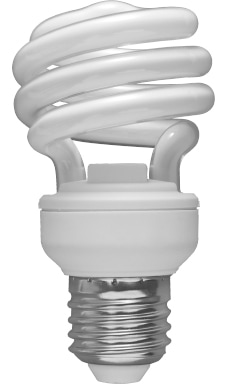
Incandescent Bulb
The fat bulbs that most of us have been using for general lighting in bedrooms since childhood are known as incandescent light bulbs. These lamps have been the standard for a long time due to the natural, warm light they produce and their undeniable low price. These bulbs are also very easy to put on a dimmer control in comparison to other lamp types.
The main problem with incandescent bulbs is that they consume two to three times more energy than the alternatives. This coupled with a much shorter lifespan (up to 1,500 hours) than its competitors makes incandescent bulbs an expensive option. This has led to a worldwide movement to ban their use for the sake of energy. Many countries, including those in the European Union, have banned incandescent bulbs.

Halogen Bulb
Halogen bulbs are a type of incandescent lamp that produces an intense light with higher color temperatures than non-halogen incandescent lamps. Halogens are most often used in track lighting systems, ultramodern light fixtures, and, believe it or not, headlights. The intensity of the light makes halogen lamps a good choice for task lighting. Halogen light bulbs tend to initially cost more than non-halogen incandescent bulbs but make up for the difference with a longer lifespan (2,000 to 2,500 hours) and higher energy efficiency.
The trouble with halogen bulbs lies in the fact that they produce a lot of heat. This makes halogen lamps a bad choice for workspaces in close proximity to a halogen lamp or for children's rooms due to safety issues. Note that you should never touch a halogen lamp with bare hands or leave flammable materials nearby. It is best not to leave with these lamps on for an extended period without someone close at hand.

Xenon Bulb
Xenon bulbs are a variation of halogen bulbs. They produce the same clear white light yet remain cooler than standard halogen bulbs. They are popular in scientific, medical, stage & studio areas as they are much brighter than standard halogen bulbs. Xenon bulbs are widely used in automobile headlights.

Fluorescent Bulb
Fluorescent lamps produce a large amount of white light that reveals detail without producing excess heat. This together with a low operating cost makes fluorescent bulbs an ideal choice for work areas.
One downfall for the fluorescent lamp is that it produces a very white light that does not seem as natural or warm as an incandescent bulb.
Fluorescent bulbs have also been accused of being harmful to the environment due to the mercury and phosphor materials contained inside. Because of this used fluorescent lamps typically cannot be disposed of as regular trash. The disposal procedure is usually regulated by local government agencies.

Compact Fluorescent Bulb (CFL)
This type of fluorescent bulb has been offered as a replacement for the incandescent bulbs that have already been banned in many countries. They are closer to incandescent bulbs in size but retain the energy saving properties. The two most common shapes are U-shaped and spiral. Recent developments have also led to a light that is more natural and similar to the light produced by incandescent bulbs.
If compared to incandescent bulbs, CFLs have a longer lifespan up to 10,000 hours, have higher luminous efficiency and are more energy efficient. But the mercury in the loops makes them difficult to dispose of.

Light Emitting Diode (LED)
Light emitting diode (LED) bulbs are currently the most energy efficient of all types of light bulbs. Though they were rather expensive at first, prices have dropped significantly since then. With lifespans that exceed those of most other bulbs and a variety of colors, these bulbs offer the best solution for your budget.
An LED bulb consists of multiple diodes producing the required amount of light. LEDs are highly energy efficient as a semiconductor and are capable of producing brighter light with less energy.

Smart Wi-Fi Light Bulb
A new approach to light bulbs is an LED-based smart bulb that can be controlled by a smartphone app or a hub. You can turn them on and off remotely via apps, control them with your voice, or set automated home lighting schedules to suit your lifestyle. These bulbs are compact, bright, have color representation and the prices are affordable starting from $8.
In Conclusion...
There are actually more types of light bulbs than those described in our article. However, these are the most popular for interior lighting. Choosing the right light bulb is all in all a matter of preference and savings. You can try different light options in home design apps that help create realistic 3D projects. One of such apps is Live Home 3D for iPhone, iPad, Mac, Android and Windows devices.